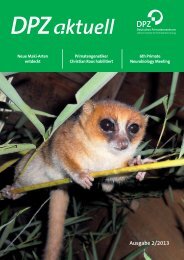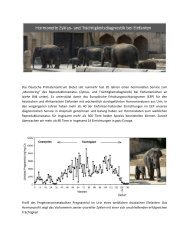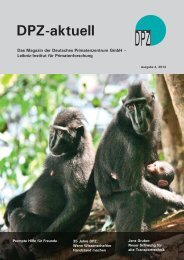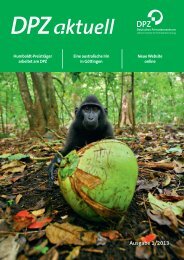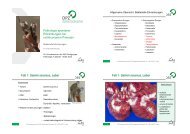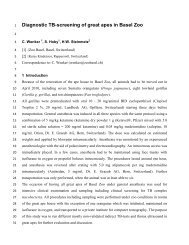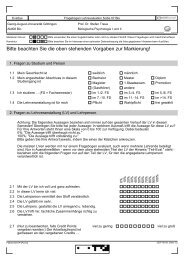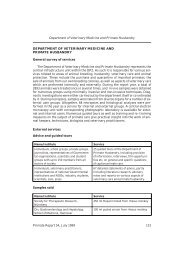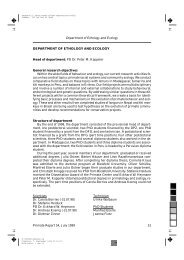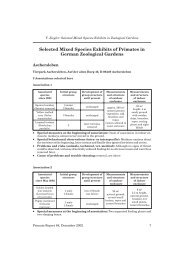Vol. 15 - Deutsches Primatenzentrum
Vol. 15 - Deutsches Primatenzentrum
Vol. 15 - Deutsches Primatenzentrum
You also want an ePaper? Increase the reach of your titles
YUMPU automatically turns print PDFs into web optimized ePapers that Google loves.
Lemur News <strong>Vol</strong>. <strong>15</strong>, 2010 Page 63<br />
found the expected heterozygosity to be higher in five out of<br />
six populations,one comparison was significantly higher (P <<br />
0.01).In E.sanfordi,Ramanamahefa et al.(2010b) found that in<br />
all populations sampled,the observed heterozygosities were<br />
higher than the expected heterozygosities. Lastly, Quéméré<br />
et al. (2009), found that their study estimated the expected<br />
heterozygosity level for several populations of P. tattersalli to<br />
be higher than the estimate found by Razafindrakoto et al.<br />
(2008) using a different marker suite in different populations.<br />
Other studies (included in Tab. 2) have estimated heterozygosity<br />
levels for one or two populations of various lemur<br />
species in recent years.While these estimates provide some<br />
general sense of genetic diversity, they are not standardized<br />
(e.g. not the same markers were used in each study) so the<br />
estimates are contingent on the polymorphic information<br />
content and amplification quality in each independent study.<br />
What we do see is a relative trend that the observed<br />
heterozygosities are in general lower, but usually not significantly,<br />
than the expected heterozygosities under the assumptions<br />
of HWE.<br />
In this study on I. indri, we found the differences among the<br />
HO estimates to differ but not significantly and the differences<br />
among the HE estimates to differ with low significance<br />
(P < 0.05). The average estimates for heterozygosity, thus<br />
genetic diversity, were in the upper range of those found in<br />
limited population studies on other lemur species. These<br />
estimate trends provide the basis for future and integrative<br />
studies where multiple species might be considered in sympatric<br />
zones to investigate the overall genetic health of the<br />
biodiversity and to better understand the effects that humans<br />
may be having on the evolutionary potential of lemurs.<br />
Acknowledgements<br />
We acknowledge the Ministry of Environment and Eaux &<br />
Forets, Madagascar National Parks, U.S. Fish & Wildlife Service,<br />
Professor Gisele and the Department of Paleontology<br />
and Anthropology, University of Antananarivo for their help.<br />
This project would not have been possible without the support<br />
of the staff, guides, and drivers of Henry Doorly Zoo<br />
and the Madagascar Biodiversity Partnership. We also wish<br />
to thank the Theodore F.and Claire M.Hubbard Family Foundation,<br />
Bill and Berniece Grewcock, the Ahmanson Foundation,<br />
the James Family Foundation and the Hawks Family<br />
Foundation for their support of this project.<br />
References<br />
Andriantompohavana, R.; Randrianamanana, J.C.; Sommer,<br />
J.A.;Brenneman,R.A.;Louis,E.E.Jr.2004.Characterization<br />
of twenty-two microsatellite loci developed from the<br />
genome of the Woolly Lemur (Avahi laniger). Mol. Ecol.<br />
Notes 4(3): 400-403.<br />
Andriantompohavana, R.; Morelli, T.L.; Behncke, S.M.; Engberg,S.E.;Brenneman,R.A.;Louis,E.E.Jr.2007.Characterization<br />
of twenty Eulemur-specific microsatellite loci characterized<br />
in two populations of the Red-Bellied Brown<br />
Lemur, Eulemur rubriventer. Mol. Ecol. Notes 7(6): 1162-<br />
1165.<br />
Bailey, C.A.; Lei, R.;Brenneman, R.A.; Louis, E.E. Jr. 2009. Characterization<br />
of 21 microsatellite loci in the Milne-Edwards<br />
sifaka (Propithecus edwardsi). Conserv. Genet. 10:<br />
1389-1392.<br />
Britt,A.;Randriamandratonirina,N.J.;Glasscock,K.D.;Iambana,<br />
B.R. 2002. Diet and feeding behaviour of Indri indri in a<br />
low-altitude rain forest. Folia Primatol. 73: 225-39.<br />
Callen, D.F.; Thompson, A.D.; Shen, Y.; Phillips, H.A.; Richards,<br />
R.I.; Mulley, J.C.; Sutherland, G.R. 1993. Incidence and<br />
origin of "null" alleles in the (AC)n microsatellite markers.<br />
Am. J. Hum. Genet. 52: 922-927.<br />
Chapuis, M.-P.; Estoup, A. 2007. Microsatellite null alleles and<br />
estimation of population differentiation. Mol. Biol. Evol.<br />
24(3): 621-631.<br />
Cornuet,J.M.;Luikart,G.1996.Description and power analysis<br />
of two tests for detecting recent population bottlenecks<br />
from allele frequency data. Genetics 144: 2001-<br />
2014.<br />
Di Rienzo,A.;Peterson,A.C.;Garza,J.C.;Valdes,A.M.;Slatkin,<br />
M.; Freimer, N.B. 1994. Mutational processes of simplesequence<br />
repeat loci in human populations. Proc. Nat.<br />
Acad. Sci. USA. 91: 3166-3170.<br />
Dieringer, D.; Schlötterer, C. 2002. Microsatellite analyser<br />
(MSA): a platform independent analysis tool for large<br />
microsatellite data sets. Mol. Ecol. Notes 1(3): 167-169.<br />
Glessner,K.D.G.;Britt,A.2005.Population density and home<br />
range size of Indri indri in a protected low altitude rain<br />
forest. Int. J. Primatol. 26(4): 855-872.<br />
Gmelin, J.F. 1788. Caroli a Linné systema naturae per regna<br />
tria naturae, secundum classes, ordines, genera, species,<br />
cum characteribus, differentiis, synonymis, locis. Tomus I.<br />
Editio decima tertia,aucta,reformata.42:1-500.Lipsiae,G.<br />
E. Beer.<br />
Golden, C. 2005. Eaten to Endangerment: Mammal hunting<br />
and the bushmeat trade in Madagascar’s Makira forest.<br />
M.S. Thesis: Accession 17105 Box 1, Harvard University<br />
Library, Cambridge, MA.<br />
Goudet, J. 1995. FSTAT, a computer program to test F-statistics.<br />
J. Hered. 86: 485-486.<br />
Goudet, J. 2001. FSTAT, a program to estimate and test gene<br />
diversities and fixation indices (version 2.9.3). Updated<br />
from Goudet (1995).<br />
Guo,S.W.;Thompson,E.A.1992.Performing the exact test of<br />
Hardy-Weinberg proportion for multiple alleles. Biometrics<br />
48: 361-372.<br />
Gray, J.E. 1872. On the varieties of Indris and Propithecus.<br />
Annals and Magazine of Natural History, London, British<br />
Museum Trustees.<br />
Hardy, O.J.; Vekemans, X. 2002. SPAGeDi: a versatile computer<br />
program to analyse spatial and genetic structure at the<br />
individual level. Mol. Ecol. Notes 2: 618-620.<br />
Harper, G.J.; Steininger, M.K.; Tucker C.J.; Juhn, D.; Hawkins, F.<br />
2007. Fifty years of deforestation and forest fragmentation<br />
in Madagascar. Environ. Conserv. 34(4): 1-9.<br />
Hill, W.G. 1981. Estimation of effective population size from<br />
data on linkage disequilibrium. Genet. Res. 38: 209-216.<br />
Hoffman, J.J.; Amos, W. 2005. Microsatellite genotyping<br />
errors: detection approaches, common sources, and consequences<br />
for paternal exclusion. Mol. Ecol. 14: 599-612.<br />
IUCN. 2008. IUCN Red List of threatened species.<br />
www.iucnredlist.org. Downloaded on 17 April 2009.<br />
Junge,R.E.;Louis,E.E.2002.Medical evaluation of free-ranging<br />
primates in Betampona Reserve, Madagascar. Lemur<br />
News 7:23-25.<br />
Kimura,M.;Crow J.F. 1964.The number of alleles that can be maintained<br />
in a finite population. Genetics 49: 725-738.<br />
Lawler, R. 2008. Testing for a historical bottleneck in wild<br />
Verreaux’s sifaka (Propithecus verreauxi verreauxi) using<br />
microsatellite data. Am. J. Primatol. 70: 990-994.<br />
Leberg, P.L. 2002. Estimating allelic richness: Effects of ample<br />
size and bottlenecks. Mol. Ecol. 11: 2445-2449.<br />
Lei, R.; McGuire, S.M.; Shore, G.D.; Louis, E.E. Jr.; Brenneman,<br />
R.A. 2008a. Characterization of twenty-one microsatellites<br />
developed from Propithecus deckeni deckeni.Mol.Ecol.<br />
Res. 8(4): 773-776.<br />
Lei, R.; McGuire, S.M.; Shore, G.D.; Louis, E.E. Jr.; Brenneman,<br />
R.A. 2008b. Characterization of twenty microsatellites<br />
developed from Propithecus deckeni coronatus with crossamplification<br />
in Propithecus deckeni deckeni. Conserv.<br />
Genet. 9(4): 999-1002.<br />
Louis, E.E. Jr.; Ratsimbazafy, J.H.; Razakamaharavo, V.R.; Pierson,<br />
D.J.; Barber, R.C.; Brenneman, R.A. 2005. Conservation<br />
genetics of black and white ruffed lemurs (Varecia variegata<br />
variegata) from southeastern Madagascar. Animal<br />
Conservation 8: 105-111.<br />
Luikart, G.; Allendorf, F.W.; Cornuet, J.-M.; Sherwin, W.B.<br />
1998. Distortion of allele frequency distributions provides<br />
a test for recent population bottlenecks. J. Hered. 89:<br />
238-247.<br />
Markolf, M.; Roos, C.; Kappeler, P. 2008. Genetic and demographic<br />
consequences of a rapid reduction in population<br />
size in a solitary lemur (Mirza coquereli). Open Conserv.<br />
Biol. J. 2: 21-29.





